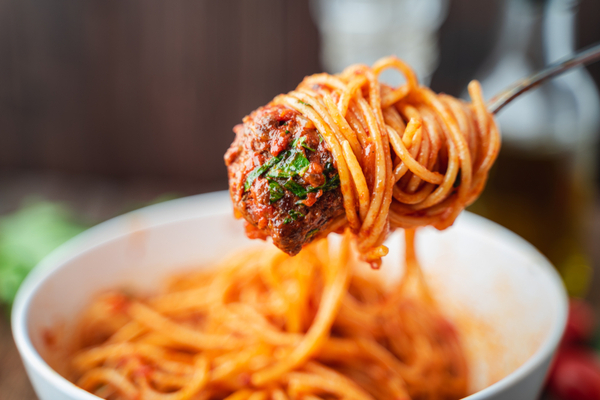Today is National Spaghetti Day! Did you know that every year, 1.3 million pounds of spaghetti were sold in American grocery stores? If all of those packages were lined up, they would circle the Earth nine times!
The first historical reference to boiled noodles (found in the Jerusalem Talmud) suggests that the Arabs invented the dish thousands of years ago. What’s remarkable about this record is that it actually refers to dried noodles purchased from a vendor, which means that pasta has been sold in stores since at least the 5th century!
Other sources say that some form of pasta originated in ancient China and was brought to Italy by Marco Polo during the 13th century. Regardless of where pasta/noodles came from originally, the spaghetti noodle shape – “spaghetti” means “little lines” in Italian – originated in Sicily/Italy. Fun fact: the average Italian eats over 50 pounds of the stuff a year.
Prior to the industrial revolution, spaghetti was actually a luxury in Italy. Thomas Jefferson is credited with popularizing macaroni in America but it was the Italian immigrants that brought spaghetti to America. Originally, 18 inches (50 cm) long, it is most commonly available in 12 inch (30cm) lengths today.
While there are numerous companies that manufacture spaghetti, the oldest pasta company and the biggest pasta factory in the world is Barilla located in Parma, Italy. Though the company manufactures 150 different pasta shapes, spaghetti remains the simplest pasta shape to produce and the Barilla factories produces miles and miles of the stuff every day.
As part of the pasta family, spaghetti, is a fat-free, low sodium food made from hard wheat. More nutrition can easily be added to a meal by using whole grain pasta options. Gluten-free pasta is also an option to those who cannot tolerate gluten.
Spaghetti is traditionally served with tomato sauce and Parmesan cheese, but you can also add meat, garlic, oil, and pepper for extra flavor. A plate of spaghetti and meatballs is the epitome of comfort food, but spaghetti is the perfect backdrop for all sorts of toppings and applications such as soups, stir frys, casseroles, and salads. You can even fry leftover spaghetti noodles!
Tips for cooking and serving spaghetti perfectly
- Salt your water. Salt raises the temperature of the water so the pasta cooks a bit faster and adds flavor.
- Use plenty of water and keep it boiling. 4-6 quarts water per pound of pasta is recommended. Bring the water to a boil before adding pasta and return to a boil after adding pasta. Using plenty of water helps prevent sticking and reduces the time it takes for the water to return to a boil when the pasta is added. Keep the water at a rolling boil during cooking and do not cover.
- Stir the pasta. Stirring occasionally encourages even cooking and prevents the strands from sticking together.
- Cook to al dente or firm to the bite. Al dente is usually reached within 8-10 minutes of putting the spaghetti into the boiling water. For recipes with extra cooking time, undercook the pasta by 1/3 of the cooking time.
- Drain and reserve some pasta water for thinning the sauce if needed.
- Plate with a twist and drizzle. Whether served in a sauce or alone, the key to plating spaghetti is to gently grab a serving of spaghetti with a tongs and give it a twist as it is placed on the plate causing the noodles to twist on themselves and pile upward. Garnish, if desired, with a drizzle of olive oil and a little grated parmesan cheese.
Here’s to spaghetti and National Spaghetti Day! Celebrate with a favorite spaghetti dish for dinner or head to your favorite Italian restaurant for a spaghetti entre. Be sure to post your spaghetti pictures on social media using #NationalSpaghettiDay. Oh, and did you know that you should not break spaghetti? Length is needed to keep the Italian tradition of twirling spaghetti on a fork (which is the only way Miss Manners says you should be allowed to use when eating it)!
—
Photo Credit: Everything is stock / Shutterstock.com
